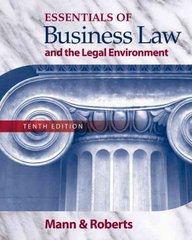Question
1.person's consumption possibilities is defined by the budget line because A) it marks the boundary between what is affordable and unaffordable. B) it represents the
1.person's consumption possibilities is defined by the budget line because
A) it marks the boundary between what is affordable and unaffordable.
B) it represents the individual's preference for different combinations of goods.
C) it marks the boundary between what can be produced and what is unattainable given the current state of technology and resources.
D) all consumers must consume on their budget line.
2.Tom's consumption possibilities is defined by
A) his income and the prices of the goods that he consumes.
B) his preferences for consumption of the goods that he consumes.
C) the prices of the goods that he consumes only.
D) his income only.
3.Utility is best defined as
A) the amount one is willing to pay for a good.
B) the price of a good.
C) the satisfaction from consuming a good.
D) the practical usefulness of a good.
4.Total utility describes
A) the benefit gained from all consumption.
B) an increase in consumption multiplied by the gain in utility.
C) total consumption multiplied by marginal utility.
D) total consumption divided by marginal utility.
5.A measure of all the satisfaction you receive from all the coffee that you consume is your
A) marginal utility of coffee.
B) marginal utility per dollar spent on coffee.
C) total utility from coffee.
D) marginal utility per dollar spent on coffee when you are in your consumer equilibrium.
6.Marginal utility is the
A) total satisfaction that a person gets from the consumption of all of the units of a good consumed.
B) change in satisfaction that results from a one-unit increase in the quantity of a good consumed.
C) maximum price that a consumer is willing to pay for an additional unit of a good.
D) additional cost to a consumer when an additional unit of a good is consumed.
7.________ is the additional satisfaction a person receives from consuming an extra unit of a good.
A) Total utility
B) Marginal utility
C) Diminishing marginal utility
D) Preferences
8.The measure of the benefit you get from consuming the next cup of coffee is your
A) marginal utility of coffee.
B) total utility from coffee.
C) total utility per dollar spent on coffee.
D) total utility from coffee when you are at your consumer equilibrium.
9.Diminishing marginal utility means that
A) Ralph will enjoy his second hamburger less than the first.
B) the total utility from one hamburger exceeds the total utility from two hamburgers.
C) the price of two hamburgers is twice the price of one.
D) beyond a certain point, total utility decreases as income rises.
10. If Pete enjoys his first pancake of the morning much more than his fifth pancake of the morning, he is exhibiting
A) utility maximizing behavior.
B) diminishing marginal utility.
C) irrational behavior.
D) diminishing total utility.
True or False:
1)Total utility is the benefit received from consuming an extra unit of a good.
2)Marginal utility diminishes as consumption of good decreases.
3)According to the principle of diminishing marginal utility, as an individual consumes more and more of a good or service, the total utility increases while the marginal utility decreases.
4)A consumer's total utility is maximized when the total utility per dollar from all goods is equalized.
5)When Kathryn spends her entire budget and equates marginal utility per dollar across all goods' Kathryn's total utility is maximized.

Step by Step Solution
There are 3 Steps involved in it
Step: 1

Get Instant Access to Expert-Tailored Solutions
See step-by-step solutions with expert insights and AI powered tools for academic success
Step: 2

Step: 3

Ace Your Homework with AI
Get the answers you need in no time with our AI-driven, step-by-step assistance
Get Started


